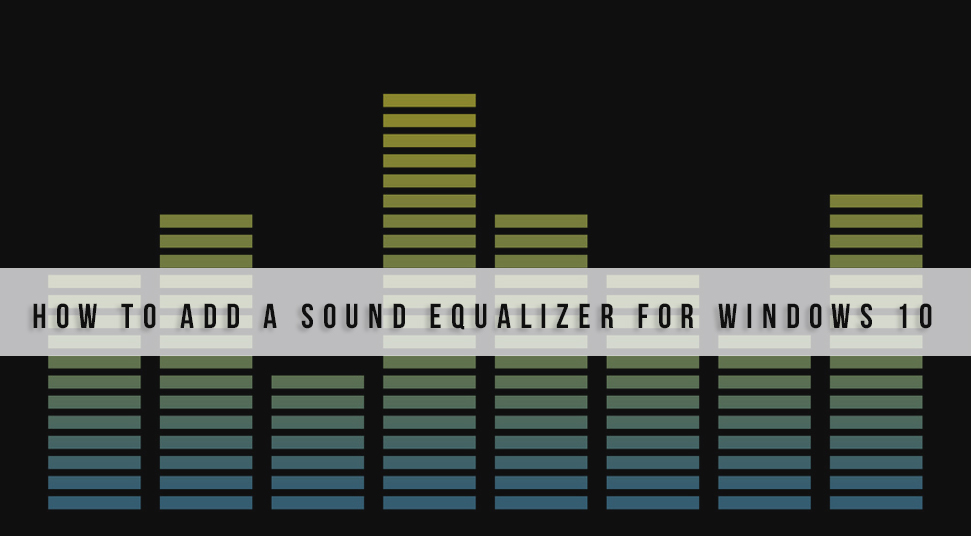

- #WINDOWS 10 EQUALIZER NOT SHOWING HOW TO#
- #WINDOWS 10 EQUALIZER NOT SHOWING FULL#
- #WINDOWS 10 EQUALIZER NOT SHOWING WINDOWS 10#
- #WINDOWS 10 EQUALIZER NOT SHOWING ANDROID#
#WINDOWS 10 EQUALIZER NOT SHOWING ANDROID#
To sweeten the deal, Windows also provides the convenience of free remote desktop from your Android phone. If you're fussy (like I am), you can change the sample rate when playing back high resolution material, but I think leaving it set at 96kHz should be more than good enough. Playing a 44.1kHz file with upsampling to 96kHz, 24 bits, and EAPO set to -0.2 dB to avoid CAudioLimiter, the highest distortion component was at -134 dB: It appears like Windows made improvements since 2015. My testing in Dec '20 shows that the Windows upsampler is probably more than good enough. Archimago showed that Windows upsampling performed poorly in 2015, but I think the jury is still out. What you see is what you get when using filters designed by REW, implemented by EAPO.Īnother question is whether automatic sample rate switching is needed in Windows, or if a fixed high sample rate can be set, relying on Windows upsampling. In a nice outcome, it turns out that the filters generated by REW using "generic filter" setting are the same filters implemented by EAPO. In short, cramping is when the PEQ filter "bell" shape gets increasingly asymmetrical as it approaches half the sample rate. These are known to cause "cramping" in high frequencies. Ignore the noise floor, it has FFT gain, but it's "way down there".ĮAPO also gets a knock for using "textbook" filters. As an example, this REW multi tone test stimulus (24 bit 44.1kHz with dither) was used in my measurements. After performing a large study of the free REW and Audacity's tone generators (including trade off with bit rate and the performance of the various types of dither), I found their performance far outstripped even professional external hardware generators costing in the thousands (full disclosure, I used to work in an audio lab). The first step was to find test signals that could be viewed as faultless, with self distortion well below 24 bits. But how about the performance of EAPO, is it "good enough"? Again, an online search turned up no answers. External hardware adds cost and ironically ties you to hardware with frequency resolution lower than Windows can deliver with a more convenient integrated free software solution like Equalizer APO. This just seemed wrong to me, it felt like giving up. The common recommendation was yet another sledgehammer: buy expensive external hardware filtering boxes (e.g. correct) my headphones regardless of what I was listening to, with Window's ease of use for all my audio sources. I want better than bit perfect: a high performance digital filter engine to correct my room modes below Schroeder or to equalize (i.e. Was the limiter at the input of Windows audio engine, the output, or both? Do all sources needed to have volume reduced or would Windows' global volume work? I decided to find out.Ī commonplace sledge hammer detente is to just give up and use ASIO or WASAPI exclusive and bypass Windows' audio engine all together, for bit perfect operation. But I've seen no study on what to do about it.
#WINDOWS 10 EQUALIZER NOT SHOWING FULL#
#WINDOWS 10 EQUALIZER NOT SHOWING WINDOWS 10#

This is fixed by adding some Windows' volume loss

I'm including supporting objective test evidence in keeping with the spirit of ASR.
#WINDOWS 10 EQUALIZER NOT SHOWING HOW TO#
Sorry for the long post but my motivation is to share how to get effectively perfect audio from Windows, to save folks money and headaches, and to help end the endless debates. I decided to investigate this as I kept hearing issues with Windows, even after following common practice to (controversially) supposedly make it clean. Sceptics counterargued that bits are bits and Windows audio degradations are a figment of an over-active audiophile imagination. A debate has been long raging in the audio community that Windows isn't fit for use in a high resolution audio system.


 0 kommentar(er)
0 kommentar(er)
